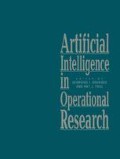Abstract
The theory of the control of stock is well understood, and a large number of firms use automatic stock control and ordering techniques as a major part of their inventory control systems. However, the effectiveness of such automatic stock control systems depends on the correct selection of system parameters for each item in the inventory and on the accurate reporting of information. It is not unusual for errors to be made in both the selection of parameters and the entry of data, and regular failures of either can cause severe problems in stock control. It is generally difficult for a human stock controller to discover errors quickly because of the large number of items that is usually found in a company inventory. This paper describes the use of an expert system to examine stock records and diagnose anomalies in the data provided or parameters applied to individual items in a stock control system. The expert system ‘reasons’ from symptoms such as reports from the forecasting system or high stock levels, to defects in the stock model used or data-collection processes, and from there to possible remedial action. Results are presented for runs of the expert system on a simulated stock control system.
Preview
Unable to display preview. Download preview PDF.
References
C. D. Lewis (1981) Scientific Inventory Control. Butterworth, London.
A. C. Hax and D. Candea (1984) Production and Inventory Management. Prentice-Hall, New York.
R. W. Blanning (1984) Management applications of expert systems. Information and Management7, 311–316.
R. Marcus (1984) An application of artificial intelligence to operational research. Comms of ACM 27, 1044–1047.
R. H. Hokans (1984) An artificial intelligence application to timber harvesting scheduling. Interfaces 14, 77–84.
T. J. Grant (1986) Lessons for OR from AI: a scheduling case study. J. Opl Res. Soc. 37, 41–57.
E. H. Shortliffe (1976) Computer-based Medical Consultations: MYCIN. Elsevier, New York.
R. Davis (1976) Applications of meta-level knowledge to the construction, maintenance and use of large knowledge bases. In Knowledge-based Systems in Artificial Intelligence (R. Davis and D. B. Lenant, Eds), pp. 229–490. McGrawHill, New York.
H. E. Pople, J. D. Myers and R. A. Miller (1975) DIALOG: a model of diagnostic logic for internal medicine. Proceedings of the Fourth International Joint Conference on Al, pp. 848–855.
H. E. Pople (1977) The formation of composite hypotheses in diagnostic problem solving: an exercise in synthetic reasoning. Proceedings of the Fifth International Joint Conference on AI, pp. 147–152.
C. D. Myers, J. Fox, S. M. Pegram and M. F. Greavfs (1983) Knowledge acquisition for expert systems: experience using EMYCIN for leukemia diagnosis. Proceedings Expert Systems 83, pp. 277–283.
J. Aitkins (1983) Prototypical knowledge for expert systems. Artificial Intelligence 20, 163–210.
J. R. Quinlan (1979) Induction over large databases. Standard University report HPP-79–14.
J. R. Quinlan (1986) Learning from Noisy Data. Machine Learning, Vol. 2. (R. S. Michalski, J. G. Carbonell, T. M. Mitchell, and J. R. Anderson, Eds). Morgan Kaufman, Los Altos, California.
J. Mingers (1987) Expert systems—rule induction with statistical data. J. Opl Res. Soc. 38, 39–48.
Author information
Authors and Affiliations
Editor information
Editors and Affiliations
Copyright information
© 1992 Operational Research Society Ltd
About this chapter
Cite this chapter
Thorpe, J.C., Marr, A., Slack, R.S. (1992). Using an Expert System to Monitor an Automatic Stock Control System. In: Doukidis, G.I., Paul, R.J. (eds) Artificial Intelligence in Operational Research. Palgrave, London. https://doi.org/10.1007/978-1-349-12362-9_10
Download citation
DOI: https://doi.org/10.1007/978-1-349-12362-9_10
Publisher Name: Palgrave, London
Print ISBN: 978-1-349-12364-3
Online ISBN: 978-1-349-12362-9
eBook Packages: EngineeringEngineering (R0)

